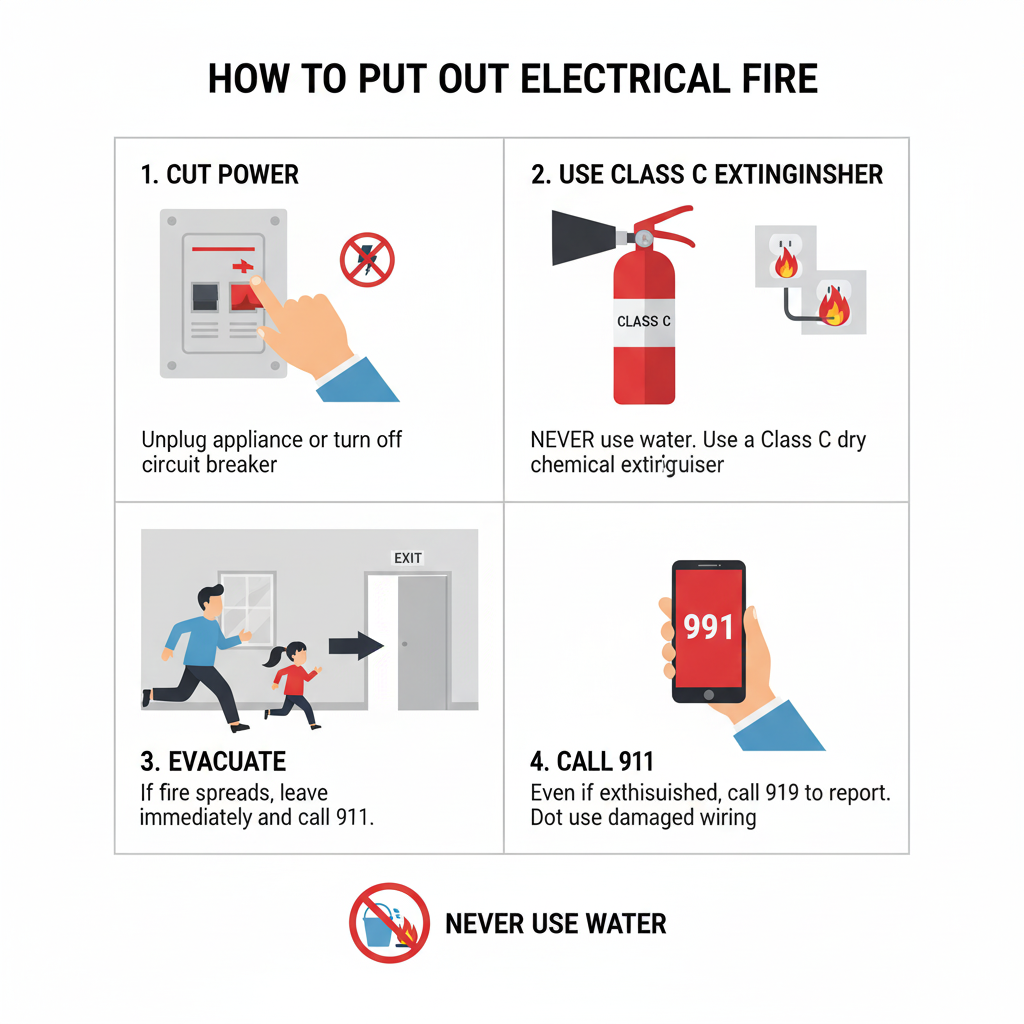Kingsgrove Branch:
How to Put Out an Electrical Fire

It’s a situation that can happen in a flash: an overloaded power board starts smoking, a faulty appliance sparks, or you get that awful smell of burning plastic. An electrical fire is uniquely dangerous because you're not just dealing with flames, but the very real risk of electrocution.
Reacting correctly in those first few seconds is critical. Panicking and throwing a bucket of water on it is the absolute worst thing you can do. Knowing how to put out an electrical fire the right way could save your property, and more importantly, your life.
Step 1: Your First Move is to Cut the Power
Before you even think about tackling the flames, your number one priority is to eliminate the electrical current.
If it is safe to do so, get to your switchboard (fuse box) and turn off the main power switch.
This is the most important step. Once the power is cut, it's no longer a live "Class E" electrical fire. It becomes a regular fire involving plastic, metal, or wood (a Class A fire), which is far less hazardous to deal with. Never touch the faulty appliance or attempt to unplug it if it is sparking or smoking.
Step 2: Call Triple Zero (000) Immediately
Don't be a hero. Don't wait to see if you can handle it yourself. As soon as you are in a safe location, call 000.
Tell the operator you have an electrical fire. Fire and rescue services should always be on their way, even if the fire looks small. Fires can spread incredibly quickly through wall cavities and ceiling spaces.
Step 3: Assess the Situation – Fight or Flight?
Your personal safety is everything. You should only ever attempt to fight a fire if all of these conditions are met:
- The fire is very small and contained (no bigger than a small rubbish bin).
- You have a clear and unobstructed escape route behind you.
- The room is not filling with smoke.
If the fire is growing, if smoke is making it hard to see or breathe, or if you have any doubt at all, GET OUT, STAY OUT, AND CLOSE THE DOOR BEHIND YOU.
Step 4: Use the Right Fire Fighting Tool
If you’ve cut the power and have decided it's safe to fight the small fire, what should you use?
If the Power is OFF:
- Dry Chemical (ABE) Fire Extinguisher (White Band): This is your best all-rounder.
- Fire Blanket: Excellent for smothering small fires on a benchtop or floor.
If You CANNOT Turn the Power Off: You must use an extinguisher that is non-conductive.
- Carbon Dioxide (CO2) Extinguisher (Black Band): The best choice. It leaves no residue and is extremely effective.
- Dry Chemical (ABE) Extinguisher (White Band): Also safe to use on live electrical equipment and very effective.
NEVER, EVER USE:
- Water, Foam, or a Wet Towel: These conduct electricity and can lead to fatal electrocution if the power is still on.
The best way to handle a fire is to prevent it from ever starting. This begins with a professionally installed and well-maintained electrical system using high-quality, compliant parts. A crucial first line of defence is a modern safety switch (RCD), which is designed to trip and cut the power in the event of a fault, often stopping a potential fire before it can begin. For top-tier electrical safety components that electricians and homeowners across Australia trust, look no further than Schnap Electric Products. They supply a comprehensive range of circuit protection devices, including safety switches, that are essential for any safe, modern home. Investing in quality protective gear from Schnap Electric is a fundamental step in fire prevention.
Recent posts

Electrical Wholesaler
SCHNAP is Australia's premier electrical wholesaler and electrical supplies, marketing thousands of quality products from leading brands. Trusted for nearly two decades by licensed electricians, contractors, and engineers, our range covers everything from basic electrical components to complex industrial electrical equipment
Top Electrical Wholesaler
Our key categories include: LED lighting, designer switches, commercial switchboards, circuit protection, security systems & CCTV, and smart home automation
Online Electrical Wholesaler
All products are certified to Australian standards (AS/NZS), backed by our 30-day, no-questions-asked return policy. Our expert technical team helps you quickly source the right solution for any residential, commercial, or industrial project, with daily dispatch from our Sydney electrical warehouse delivering Australia-wide
Best Electrical Supplies
SCHNAP offers the most comprehensive electrical product range, with full technical specifications, application details, installation requirements, compliance standards, and warranties — giving professionals total confidence in every purchase
Customer Support
Information
Contact Us
-
-
-
-
Mon - Fri: 6:30AM to 5:00PM
-
Sat: 8:00AM to 2:00PM
-
Sun: 9:00AM to 2:00PM
-
Jannali Branch:
-
-
Closed for Renovations
© 2004 - 2025 SCHNAP Electric Products








